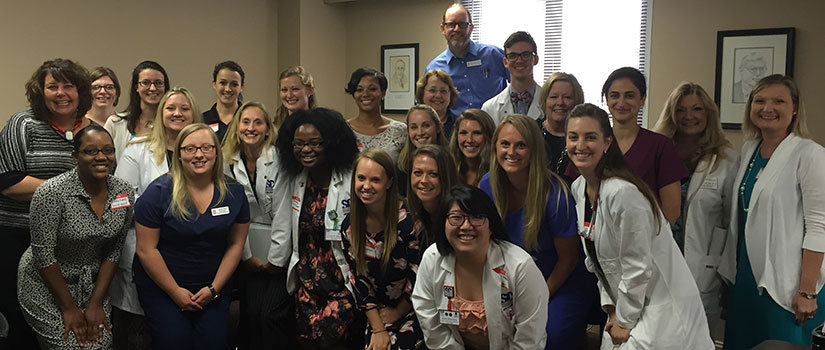June 17, 2015 | Erin Bluvas, bluvase@sc.edu
As a follow up to the Interprofessional Education (IPE) course, Transforming Healthcare for the Future, faculty and staff members from public health (speech-language pathology (Communication Sciences and Disorders) and physical therapy (Exercise Science)), social work, nursing and pharmacy vowed to provide an opportunity for students to apply their knowledge through an Interprofessional Practice (IPP) event (See video 1, video 2). IPP involves two or more professions working together with the ultimate goal of figuring out what’s best for the patient.
The Arnold School’s Department of Communication Sciences and Disorders (COMD) recruited three aphasia patients (i.e., individuals with impaired comprehension and/or communication abilities, often due to stroke) with a range of limitations to participate in the June 9 event during National Aphasia Awareness month. The event coordinators (Senior Clinical Instructor and USC Speech and Hearing Research Center Director Danielle Varnedoe, Clinical Assistant Professor Charley Adams, Senior Clinical Instructor Sarah Scarborough) believe that aphasia patients were an appropriate choice because of the limited awareness and experience working with aphasia patients for most of the students as well as the large stroke population that they will likely encounter as professionals.
Each discipline recruited three students and one faculty member to participate. By briefing them on the patients in advance, the organizers ensured that the participants had important information, such as medications and mobility limitations. On the day of the event, a student from each discipline stayed in the room with a patient and his caregiver while the faculty members rotated among the three patient rooms, facilitating the assessments. By limiting the participation, the students could take on a bigger role in the assessment than they might if there were so many participants that only observations would be possible. After all of the screenings were complete, the students gathered with others in their discipline to share their findings on the patients and discuss their insights and questions. The five-member teams then met to discuss the individual patients and findings from each assessment.
Faculty and students were excited about the learning outcomes derived from the assessments and follow-up discussions. Even though each discipline carries its own perspective, the students found it helpful to observe the different approaches and points of view. “It was helpful to know each professional’s role more in depth to facilitate treatment approaches in the future,” a speech-language pathology student said in a feedback survey. “(It was helpful) to work with other professions, see what their evaluations are like and how helpful it is to have information from all disciplines,” a physical therapy student wrote.
“There were areas where we saw some overlap between the disciplines,” Adams notes. “Some of the questions were similar—for example, speech-language pathology and social work students both asked questions about quality of life and life participation.” The coordinators also learned that while they were used to working with aphasia patients, students from other disciplines might not be aware of the nuances involved in communicating with these patients. “It was important that the caregivers were there,” Adams says. “Some students did not know the best way to pose a question or how to interpret a response, so they learned that caregivers often fulfill an important role in ensuring that patients and practitioners communicate effectively together.”
With those lessons in mind, the COMD team plans to expose their health sciences peers to working with other types of patients as well. “We have a large patient population with various disabilities across age groups,” says Varnedoe, who plans to continue to recruit patients from the Center where the event was held. Their access to patients, who are more than happy to help strengthen the future health sciences workforce, is something they are excited to share. “It (this event) allowed me to visualize what team-based care can look like,” says a student from the College of Social Work. “It also breaks down barriers among the professions.”
The faculty members plan to convene in the fall to begin planning the next IPP event. They also intend to transform video footage from the inaugural session into usable materials for classroom instruction and other educational tools in order to extend the reach of these lessons beyond those who were able to participate in person. The team will select a new population (e.g., preschool age children) for the next event and discuss ways to align the approaches from each discipline, such as integrated screening tools.
Ideally, these efforts will teach students about the concept of IPP and to value it so they will incorporate it in their future work. “It is critical that everyone is on the same page and communicating with one another in a clinical setting; improved patient outcomes is the goal,” Varnedoe says. “Interprofessional collaboration makes this possible.” The team points out that this approach is best applied through interaction during assessment—with everyone present, rather than reading over notes at different appointments.
As an added benefit, the IPP environment helps define roles and facilitate mutual respect. Students from other disciplines better understand the scope of practice and importance of all team members to improve patient care. Learning this first is crucial to the overall success of interprofessional practice.
